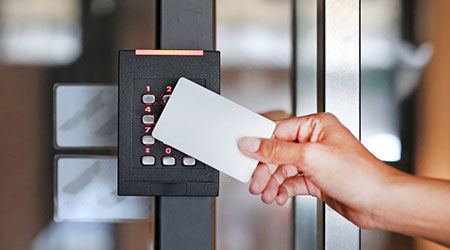Access control has long been a useful tool for healthcare facilities seeking to balance creating a safe and secure environment with one that is open and welcoming. The technology enables hospitals to allow patients and visitors to freely come and go, while also protecting patient, staff and assets. It works for general entry, such as buzzing people into a specific ward, but also serves to protect high-security areas, restricting access only to authorized personnel.
In the face of a global pandemic, the importance of access control has become even more pronounced. Today, the technology is being used to help healthcare facilities mitigate the spread of disease by eliminating common touch points, isolating infected patients, and enabling healthcare providers to treat and communicate with patients from a safe distance when needed. Like many of today’s security technologies, access control’s potential has expanded in accordance with real-world needs.
Improving security and patient care
Traditionally, the purpose of access control has been to keep patients, staff, and visitors safe, without sacrificing the type of open environment that is conducive to healing. That remains partially true, but today security is just a part of the broader purpose. Hospitals are increasingly asking not just for effective protections, but for ways to improve patient care. Where access control was formerly designed simply to protect physical spaces, it has become increasingly integrated with other systems within the healthcare field. As the needs of the industry have changed, access control technology has responded accordingly.
One example of this is touchless entry. Electronic access control has become incredibly common within healthcare facilities, and generally comes in the form of a card reader or push-button control. In addition to allowing only authorized personnel access to restricted areas, these door stations also control general entry to different areas of the facility. In light of the current pandemic, developers have begun to shift away from buttons and cards toward a touchless model, with some opting to invest in biometric technology and others utilizing apps that users can install on their own personal devices.
It is also important to remember that it isn’t just people that need protection during a pandemic: it’s equipment, too. Personal protective equipment (PPE) needs to be safely and securely stored where it can’t become contaminated. Access control equipped with touchless entry can help make equipment storage safer as well.
Integrating access control with other systems
Access control technology has, in many cases, been integrated with cameras at door stations to recognize patients or doctors and grant them frictionless entry to the appropriate areas. Integration with cameras and speakers has even enabled access control to be implemented on an individual level: high-risk patients can have access to their rooms restricted, and electronic “fencing” can also allow cameras to detect if a patient leaves their bed and crosses a certain threshold, raising an alert if the patient attempts to leave the room or falls.
Analytics can also play a role here. Acoustic analytics, for instance, have been used in other contexts to listen for aggressive behavior—also highly valuable in a healthcare setting—but can now be trained to listen for coughs or other signs of distress. Two-way intercoms in patient rooms also enable seamless communication between patient and caregiver, allowing contagious or immunocompromised patients to continue receiving high-quality care, even as doctors and nurses restrict their physical contact with the patient.
Cameras can also do more than just digital fencing: within patient rooms, they can help document whether proper PPE and incident response procedures are being followed by those entering and exiting. In high-traffic areas like hospital lobbies and waiting rooms, cameras can also be trained to detect loitering and queueing. They can then raise an alert that an additional receptionist is needed to prevent a large cluster of people from forming, working hand-in-hand with the hospital’s access control technology to further mitigate the spread of disease.
Preventing the spread of disease through access control
Healthcare facilities are facing an unprecedented challenge, and their approach to access control has changed appropriately. Where the technology was once used almost exclusively to control access to floors or wards, many hospitals have quickly adapted the technology for use on a smaller scale. The difficulty of treating patients infected with a highly contagious virus has given rise to a more personalized approach to access control, one more capable of helping doctors more effectively isolate and monitor individual patients.
Thankfully, hospitals have proven more than up to the challenge. Today’s access control technology is more adaptable and accessible than ever, and its ability to integrate with both video and audio technology has proven to be a major benefit for hospitals looking to protect patients and staff. Access control is now being used to secure public and private areas, to protect both human beings and medical equipment, and even to document that they are receiving the highest quality of care. As hospitals continue to work toward preventing the spread of infectious diseases, it is becoming increasingly clear that today’s access control technology is a critical part of any comprehensive solution.
Paul Baratta is Segment Development Manager for Healthcare at Axis Communications.

 Design Plays a Role in the Future of Healthcare
Design Plays a Role in the Future of Healthcare Cedar Hill Regional Medical Center GW Health Officially Opens
Cedar Hill Regional Medical Center GW Health Officially Opens Designing Healthcare Facilities for Pediatric and Geriatric Populations
Designing Healthcare Facilities for Pediatric and Geriatric Populations Kaiser Permanente Announces New Hospital Tower at Sunnyside Medical Center
Kaiser Permanente Announces New Hospital Tower at Sunnyside Medical Center Building Disaster Resilience Through Collaboration
Building Disaster Resilience Through Collaboration